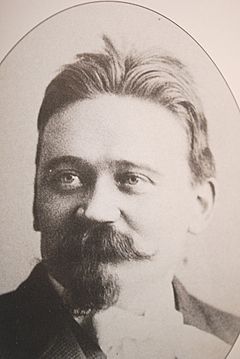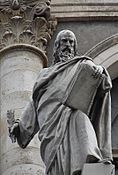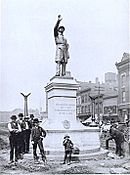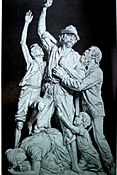Johannes Gelert facts for kids
Johannes Sophus Gelert (born 1852, died 1923) was a talented sculptor. He was born in Denmark. In 1887, he moved to the United States. For over 30 years, he created many public artworks. You can find his sculptures in the Midwest and on the East Coast of the U.S.
Contents
About Johannes Gelert
Johannes Gelert was born on December 10, 1852. His hometown was Nybøl in southern Denmark. From a young age, he showed a gift for art. In 1866, his family moved to Copenhagen. There, he became a woodcarver's apprentice.
In 1870, he joined the Royal Danish Academy of Fine Arts. He studied hard and graduated with honors in 1875. For the next ten years, he traveled and learned. He worked in Denmark, Sweden, Germany, France, and Italy. He even became a student of some of Europe's best sculptors.
Moving to America
In 1887, Gelert moved to America. He set up his art studios in Chicago. He became a U.S. citizen in 1892. Four years later, he married Georgine Sundberg. They had three children together.
In 1898, he moved his studios to New York City. He lived there until he passed away on November 3, 1923.
Exhibitions and Awards
Johannes Gelert showed his sculptures at many important events. These included big world's fairs. He displayed his art at the 1893 World's Columbian Exposition in Chicago. He also showed his work at the 1901 Pan-American Exposition in Buffalo. Other shows were the 1904 Louisiana Purchase Exposition in St. Louis and the 1915 Panama–Pacific International Exposition in San Francisco.
Gelert won gold medals three times for his amazing sculptures.
- In 1897, he won for "Wounded American Soldier." This was at the Tennessee Centennial and International Exposition in Nashville.
- In 1899, he won for "Little Architect." This was at an exhibition by the Art Club of Philadelphia.
- In 1902, he won for "Theseus, Victor over the Minotaur." This award was from the American Art Society in Philadelphia.
Public Artworks to See
Johannes Gelert created many sculptures that people can still see today.
Ulysses S. Grant Statue
In 1890, Gelert made a bronze statue of President Ulysses S. Grant. A publisher named Herman H. Kohlsaat paid for it. The statue was placed in Grant Park in Galena, Illinois. It was officially shown to the public on June 3, 1891.
The statue shows Grant as a regular citizen. He has his right hand in his pocket. Gelert wanted it to look like "you knew him." Grant's wife, Julia Grant, didn't like the hand in the pocket at first. But she approved the final statue.
John H. Stevens Statue
In 1912, Gelert created a statue of John H. Stevens. Stevens was an early settler in Minneapolis. The statue was based on drawings by another sculptor, Jacob Fjelde. It was first in downtown Minneapolis. Later, it moved to a popular park in the city.
Other Famous Locations
You can find more of Gelert's art in well-known places. These include the Brooklyn Museum. In Chicago, his work is at the Auditorium Theatre and Lincoln Park. The St. Louis Art Museum also has his art. He also designed a large memorial. It is the tomb of businessman Francis Furman at Mount Olivet Cemetery in Nashville.
Haymarket Memorial
One of Gelert's most famous pieces is the Haymarket Memorial. It shows a Chicago policeman with his arm raised. It was first shown in Haymarket Square on May 30, 1889.
Over time, the statue faced some challenges. It was hit by a streetcar and painted black. It was also targeted during the Vietnam War era. Because of this, it was moved in the early 1970s. Now, it is kept in secure locations at the Chicago Police Department headquarters.
Historians say Gelert's artworks showed interesting ideas. They often explored themes about different economic groups, work, and social changes.
Lost Artworks
Some of Johannes Gelert's artworks are no longer around.
McVicker's Theatre Panels
After a big fire in 1890, McVicker's Theatre in Chicago was rebuilt. Gelert made two special panels for it. One panel showed the journey of René-Robert Cavelier, Sieur de La Salle. This represented Christianity coming to Illinois. The other panel showed the Battle of Fort Dearborn massacre. This symbolized the struggle between old ways and new civilization. The theater building was torn down in 1922.
Beethoven Bust
In 1897, Gelert made a bronze bust of Ludwig van Beethoven. This statue stood in Lincoln Park for over 70 years. Sadly, it was stolen in 1971. Only a small piece of its base remains today.
Dewey Arch
In 1899, Gelert was one of many sculptors who worked on the Dewey Arch. This arch honored Admiral George Dewey. It celebrated his victory in the Battle of Manila Bay. The monument was built for a parade on September 30, 1899.
However, the arch was made of a material called staff. This material was often used for temporary structures. Soon after the celebration, the arch started to fall apart. People tried to raise money to rebuild it with stronger materials, but they couldn't. So, the arch was eventually taken down.
Gallery
-
St. Augustine at Frederik's Church in Copenhagen, 1885
-
Bronze statue of Ulysses S. Grant Grant Park Galena, Illinois, 1890
-
Gothic art at the St. Louis World's Fair, 1904









